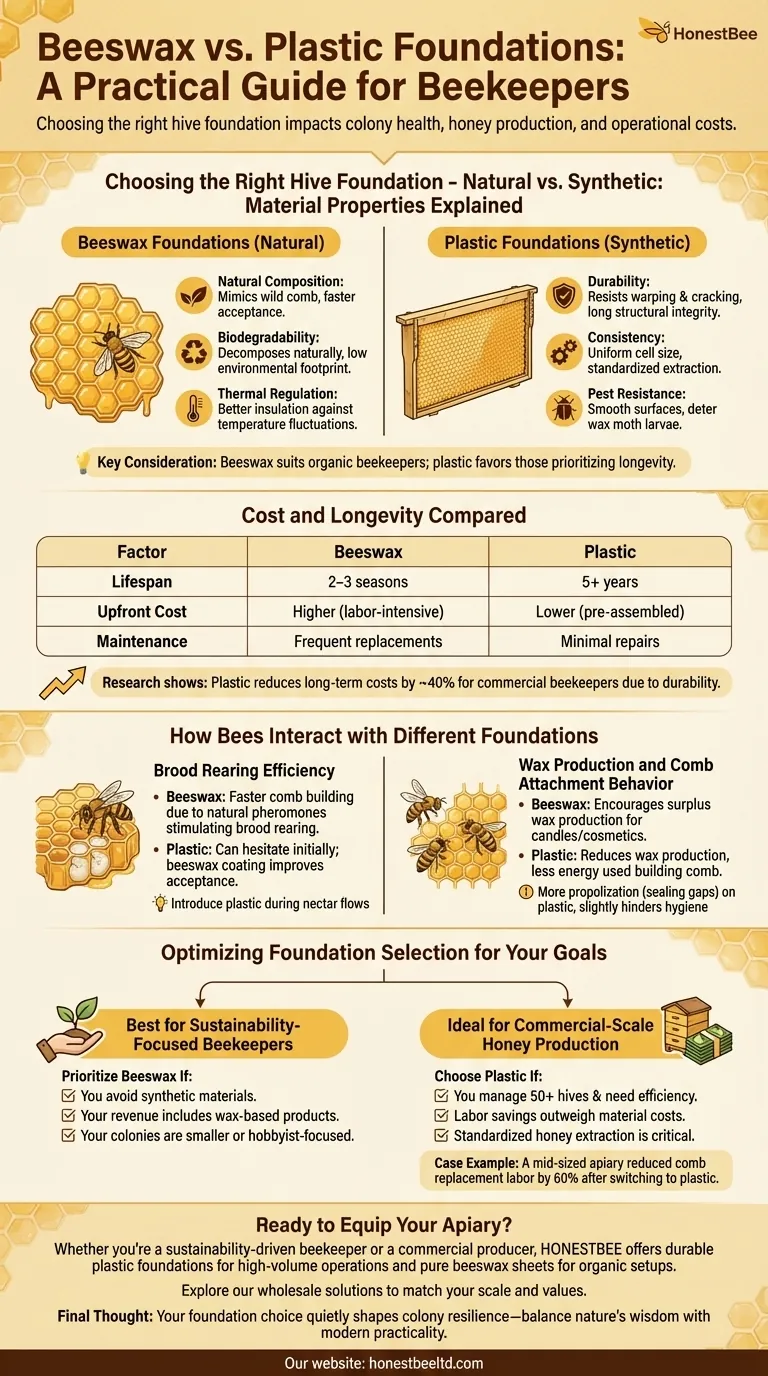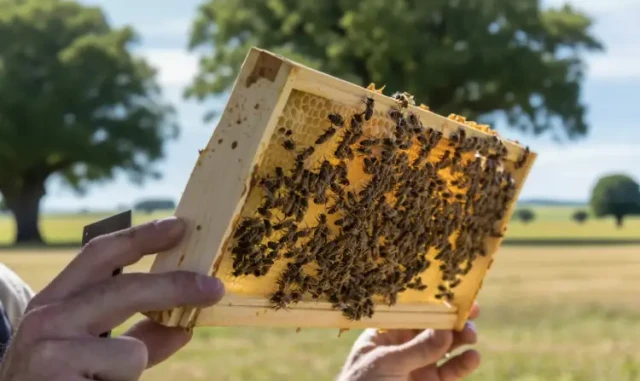La scelta del giusto fondo per l'arnia influisce sulla salute della colonia, sull'efficienza della produzione di miele e sui costi operativi a lungo termine. Questa guida confronta i fondi di cera d'api e di plastica in termini di durabilità, comportamento delle api e sostenibilità, aiutandoti ad allineare la tua scelta ai tuoi obiettivi apistici.
Scegliere il giusto fondo per l'arnia
Naturale vs. Sintetico: proprietà dei materiali spiegate
Fondi di cera d'api
- Composizione naturale: Realizzati con cera d'api secreta, questi fondi imitano le strutture dei favi selvatici, incoraggiando una più rapida accettazione da parte della colonia.
- Biodegradabilità: Si decompone naturalmente, riducendo l'impatto ambientale.
- Regolazione termica: La cera d'api isola meglio dalle fluttuazioni di temperatura.
Fondi di plastica
- Durabilità: Resiste all'imbarcamento e alle crepe, mantenendo l'integrità strutturale per anni.
- Consistenza: La dimensione uniforme delle celle aiuta l'estrazione standardizzata del miele.
- Resistenza ai parassiti: Le superfici lisce possono scoraggiare l'attacco delle larve di tarma della cera.
Considerazione chiave: la cera d'api è adatta agli apicoltori biologici; la plastica favorisce coloro che danno priorità alla longevità.
Costi e longevità a confronto
| Fattore | Cera d'api | Plastica |
|---|---|---|
| Durata | 2–3 stagioni | 5+ anni |
| Costo iniziale | Più alto (ad alta intensità di manodopera) | Più basso (pre-assemblato) |
| Manutenzione | Sostituzioni frequenti | Riparazioni minime |
La ricerca mostra: la plastica riduce i costi a lungo termine di circa il 40% per gli apicoltori commerciali grazie alla sua durabilità.
Come le api interagiscono con diversi fondi
Efficienza di allevamento della covata per tipo
- Cera d'api: Le colonie spesso costruiscono i favi più velocemente sulla cera naturale, poiché emette feromoni che stimolano l'allevamento della covata.
- Plastica: Alcune colonie esitano inizialmente a costruire i favi, ma si adattano nel tempo. Rivestire la plastica con cera d'api ne migliora l'accettazione.
Suggerimento: per le nuove arnie, introduci i fondi di plastica durante i periodi di flusso nettarifero, quando le api sono più attive nella costruzione dei favi.
Produzione di cera e comportamento di attacco dei favi
- Fondi di cera d'api: Incoraggiano le api a produrre cera in eccesso, utile per sottoprodotti di candele o cosmetici.
- Fondi di plastica: Riducono la produzione di cera poiché le api spendono meno energia nella costruzione dei favi.
Osservazione: le api propolizzano (sigillano le fessure) più pesantemente sulla plastica, il che può ostacolare leggermente l'igiene dell'arnia.
Ottimizzare la scelta del fondo per i tuoi obiettivi
Il meglio per gli apicoltori focalizzati sulla sostenibilità
-
Dai priorità alla cera d'api se:
- Eviti materiali sintetici.
- Il tuo fatturato include prodotti a base di cera.
- Le tue colonie sono più piccole o focalizzate sugli hobbisti.
Ideale per la produzione di miele su scala commerciale
-
Scegli la plastica se:
- Gestisci più di 50 arnie e hai bisogno di efficienza.
- I risparmi di manodopera superano i costi dei materiali.
- L'estrazione standardizzata del miele è fondamentale.
Caso di studio: un apiario di medie dimensioni ha ridotto il lavoro di sostituzione dei favi del 60% dopo essere passato alla plastica.
Pronto ad equipaggiare il tuo apiario?
Che tu sia un apicoltore orientato alla sostenibilità o un produttore commerciale, HONESTBEE offre fondi di plastica resistenti per operazioni ad alto volume e fogli di cera d'api pura per allestimenti biologici. Esplora le nostre soluzioni all'ingrosso per adattarle alla tua scala e ai tuoi valori.
Pensiero finale: la tua scelta del fondo modella silenziosamente la resilienza della colonia: bilancia la saggezza della natura con la praticità moderna.
Guida Visiva

Prodotti correlati
- Fogli di fondotinta in cera d'api Fondotinta d'alveare per la vendita all'ingrosso
- Fondazione di plastica per api di grado alimentare per telai di api
- Macchina di fondazione manuale a pettine di cera d'api Mulino di fondazione di cera Macchina di goffratura
- Preparazione professionale del telaio: L'incastonatore a filo elettrico HONESTBEE
- HONESTBEE Strumento professionale per alveari a manico lungo con lama di taglio di precisione
Articoli correlati
- Come gli Apicoltori Possono Scegliere il Rinforzo del Favetto Giusto per la Salute e la Durata dell'Alveare
- Perché le tue api rifiutano la cera artificiale e come garantirne l'accettazione
- Caos e Ordine: Il Valore Strategico della Cera d'Api
- Fondazioni di plastica o di cera: Una guida guidata dai dati per il successo dell'apicoltura
- Stanco di favi cedevoli? Il costo nascosto dei telaini da apicoltura "economici"




















